Literature Review on Violence, Bullying, and Incivility in Nursing
VerifiedAdded on 2023/06/08
|24
|5468
|78
Literature Review
AI Summary
This literature review explores the pervasive issues of bullying, incivility, and violence in the nursing workplace, drawing upon various authors' perspectives and research findings. It highlights that such behaviors, including physical, verbal, psychological, and social abuse, have significant impacts on nurses' well-being, job satisfaction, and the quality of patient care. The review addresses the factors contributing to these problems, such as decreased health funding, increased accountabilities, and changing healthcare practices, and it considers the economic impact of incivility and bullying on the workforce. The review also examines the different forms of workplace violence, including those perpetrated by colleagues, patients, and external individuals, and emphasizes the need for a multifaceted approach involving all stakeholders—nursing staff, employers, educators, and regulatory bodies—to promote respectful and violence-free workplaces. Desklib provides access to similar solved assignments and past papers for students.
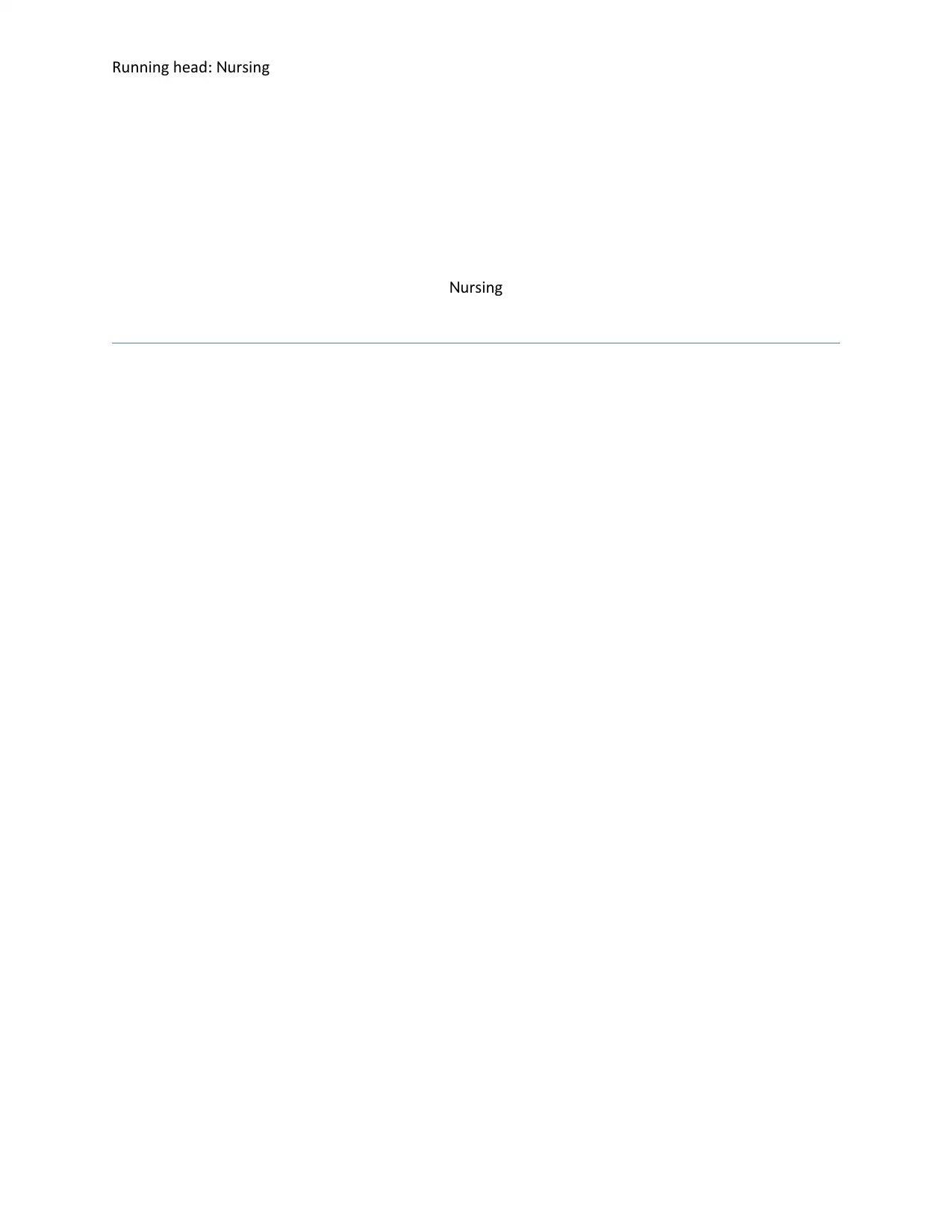
Running head ursing: N
ursingN
ursingN
Paraphrase This Document
Need a fresh take? Get an instant paraphrase of this document with our AI Paraphraser
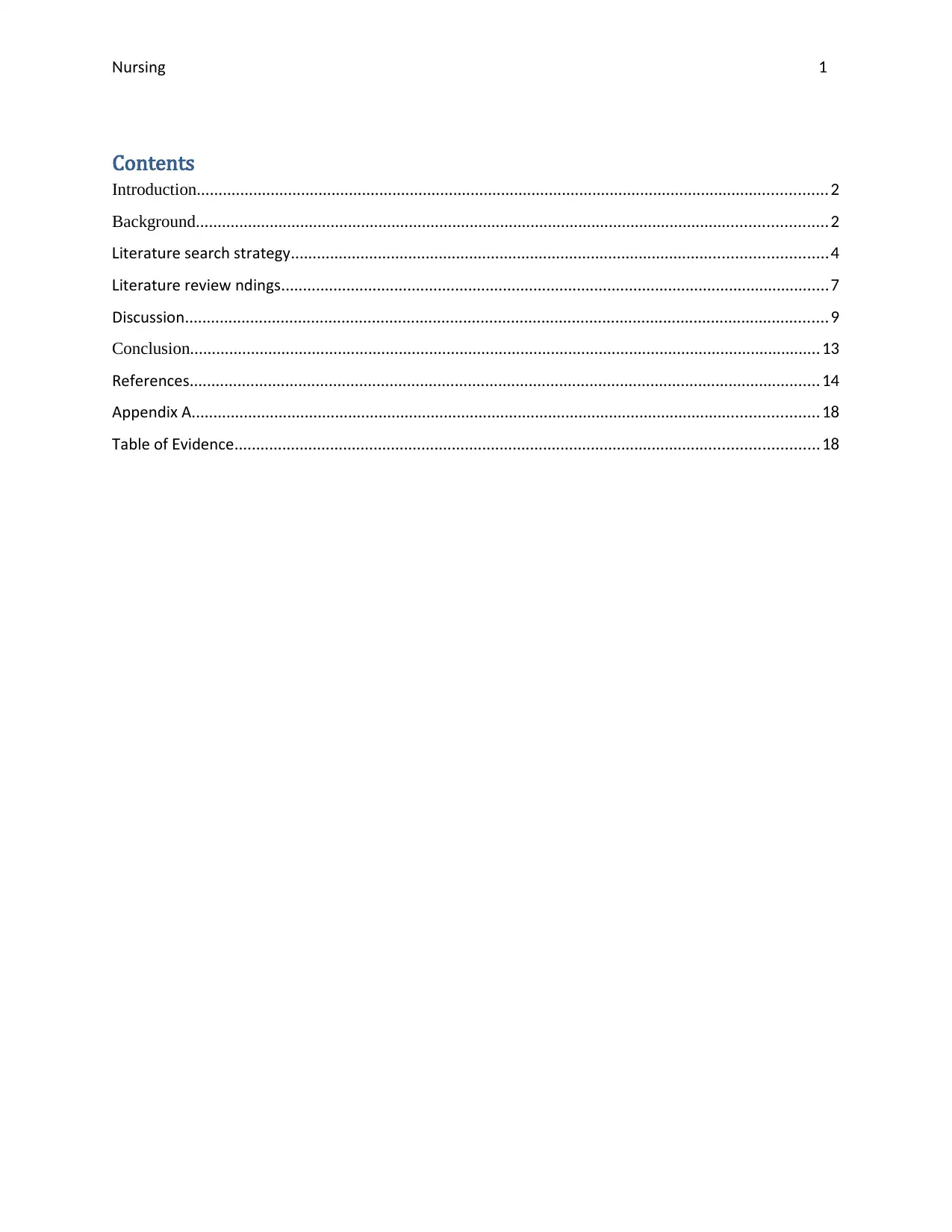
ursingN 1
Contents
Introduction.................................................................................................................................................2
Background.................................................................................................................................................2
iterature search strategyL ...........................................................................................................................4
iterature review fi ndingsL ..............................................................................................................................7
Discussion....................................................................................................................................................9
Conclusion.................................................................................................................................................13
References.................................................................................................................................................14
Appendi Ax ................................................................................................................................................18
able of videnceT E ......................................................................................................................................18
Contents
Introduction.................................................................................................................................................2
Background.................................................................................................................................................2
iterature search strategyL ...........................................................................................................................4
iterature review fi ndingsL ..............................................................................................................................7
Discussion....................................................................................................................................................9
Conclusion.................................................................................................................................................13
References.................................................................................................................................................14
Appendi Ax ................................................................................................................................................18
able of videnceT E ......................................................................................................................................18
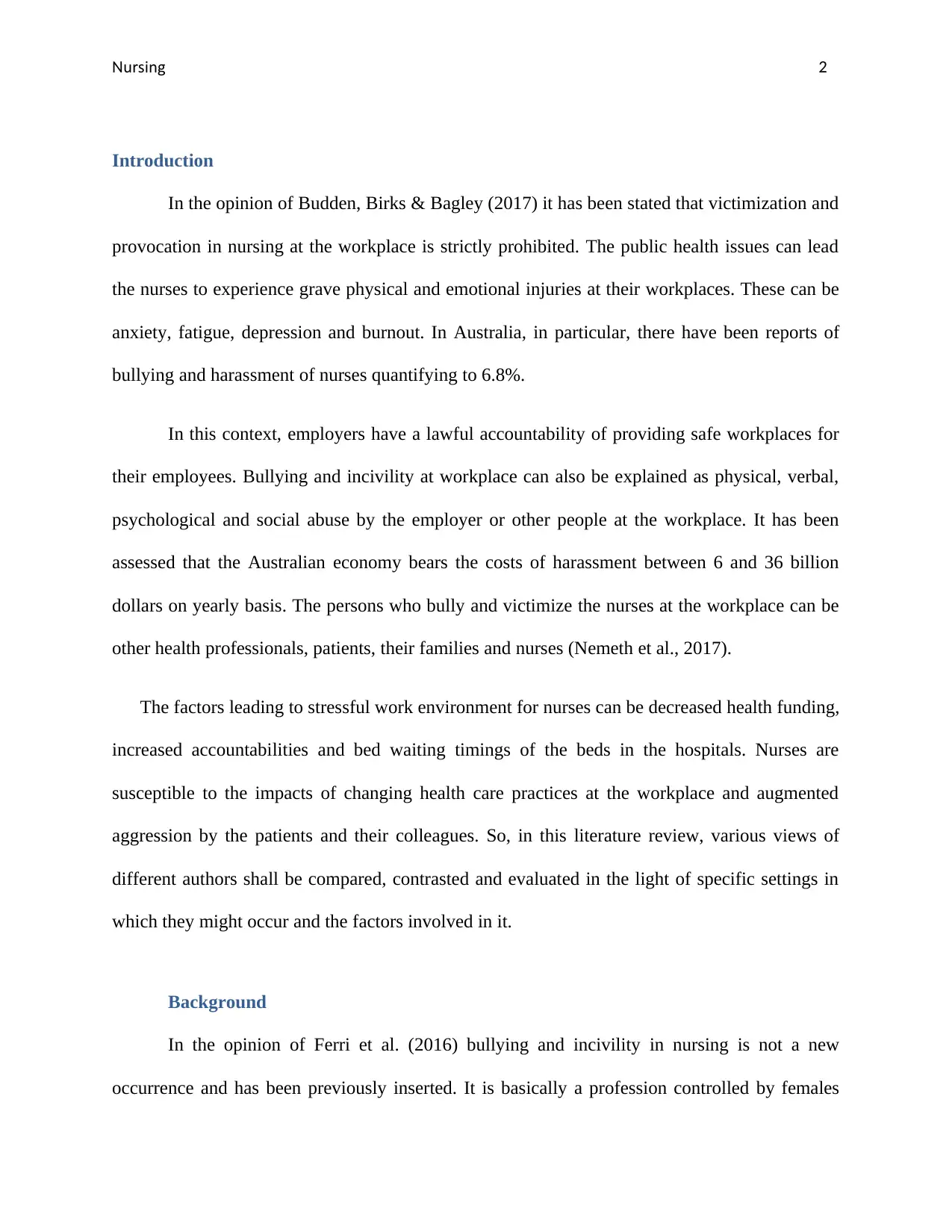
ursingN 2
Introduction
In the opinion of Budden, Birks & Bagley (2017) it has been stated that victimization and
provocation in nursing at the workplace is strictly prohibited. The public health issues can lead
the nurses to experience grave physical and emotional injuries at their workplaces. These can be
anxiety, fatigue, depression and burnout. In Australia, in particular, there have been reports of
bullying and harassment of nurses quantifying to 6.8%.
In this context, employers have a lawful accountability of providing safe workplaces for
their employees. Bullying and incivility at workplace can also be explained as physical, verbal,
psychological and social abuse by the employer or other people at the workplace. It has been
assessed that the Australian economy bears the costs of harassment between 6 and 36 billion
dollars on yearly basis. The persons who bully and victimize the nurses at the workplace can be
other health professionals, patients, their families and nurses (Nemeth et al., 2017).
The factors leading to stressful work environment for nurses can be decreased health funding,
increased accountabilities and bed waiting timings of the beds in the hospitals. Nurses are
susceptible to the impacts of changing health care practices at the workplace and augmented
aggression by the patients and their colleagues. So, in this literature review, various views of
different authors shall be compared, contrasted and evaluated in the light of specific settings in
which they might occur and the factors involved in it.
Background
In the opinion of Ferri et al. (2016) bullying and incivility in nursing is not a new
occurrence and has been previously inserted. It is basically a profession controlled by females
Introduction
In the opinion of Budden, Birks & Bagley (2017) it has been stated that victimization and
provocation in nursing at the workplace is strictly prohibited. The public health issues can lead
the nurses to experience grave physical and emotional injuries at their workplaces. These can be
anxiety, fatigue, depression and burnout. In Australia, in particular, there have been reports of
bullying and harassment of nurses quantifying to 6.8%.
In this context, employers have a lawful accountability of providing safe workplaces for
their employees. Bullying and incivility at workplace can also be explained as physical, verbal,
psychological and social abuse by the employer or other people at the workplace. It has been
assessed that the Australian economy bears the costs of harassment between 6 and 36 billion
dollars on yearly basis. The persons who bully and victimize the nurses at the workplace can be
other health professionals, patients, their families and nurses (Nemeth et al., 2017).
The factors leading to stressful work environment for nurses can be decreased health funding,
increased accountabilities and bed waiting timings of the beds in the hospitals. Nurses are
susceptible to the impacts of changing health care practices at the workplace and augmented
aggression by the patients and their colleagues. So, in this literature review, various views of
different authors shall be compared, contrasted and evaluated in the light of specific settings in
which they might occur and the factors involved in it.
Background
In the opinion of Ferri et al. (2016) bullying and incivility in nursing is not a new
occurrence and has been previously inserted. It is basically a profession controlled by females
⊘ This is a preview!⊘
Do you want full access?
Subscribe today to unlock all pages.

Trusted by 1+ million students worldwide
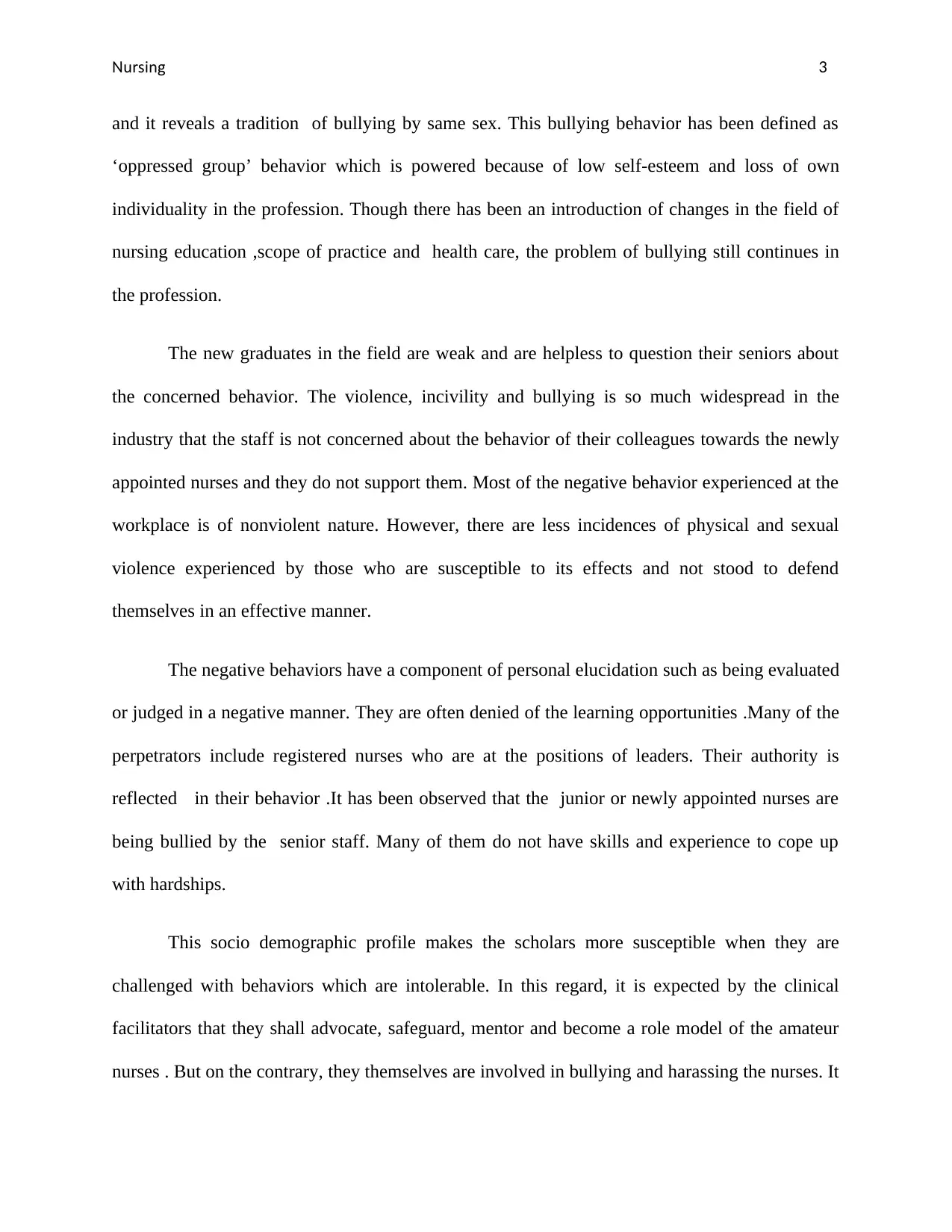
ursingN 3
and it reveals a tradition of bullying by same sex. This bullying behavior has been defined as
‘oppressed group’ behavior which is powered because of low self-esteem and loss of own
individuality in the profession. Though there has been an introduction of changes in the field of
nursing education ,scope of practice and health care, the problem of bullying still continues in
the profession.
The new graduates in the field are weak and are helpless to question their seniors about
the concerned behavior. The violence, incivility and bullying is so much widespread in the
industry that the staff is not concerned about the behavior of their colleagues towards the newly
appointed nurses and they do not support them. Most of the negative behavior experienced at the
workplace is of nonviolent nature. However, there are less incidences of physical and sexual
violence experienced by those who are susceptible to its effects and not stood to defend
themselves in an effective manner.
The negative behaviors have a component of personal elucidation such as being evaluated
or judged in a negative manner. They are often denied of the learning opportunities .Many of the
perpetrators include registered nurses who are at the positions of leaders. Their authority is
reflected in their behavior .It has been observed that the junior or newly appointed nurses are
being bullied by the senior staff. Many of them do not have skills and experience to cope up
with hardships.
This socio demographic profile makes the scholars more susceptible when they are
challenged with behaviors which are intolerable. In this regard, it is expected by the clinical
facilitators that they shall advocate, safeguard, mentor and become a role model of the amateur
nurses . But on the contrary, they themselves are involved in bullying and harassing the nurses. It
and it reveals a tradition of bullying by same sex. This bullying behavior has been defined as
‘oppressed group’ behavior which is powered because of low self-esteem and loss of own
individuality in the profession. Though there has been an introduction of changes in the field of
nursing education ,scope of practice and health care, the problem of bullying still continues in
the profession.
The new graduates in the field are weak and are helpless to question their seniors about
the concerned behavior. The violence, incivility and bullying is so much widespread in the
industry that the staff is not concerned about the behavior of their colleagues towards the newly
appointed nurses and they do not support them. Most of the negative behavior experienced at the
workplace is of nonviolent nature. However, there are less incidences of physical and sexual
violence experienced by those who are susceptible to its effects and not stood to defend
themselves in an effective manner.
The negative behaviors have a component of personal elucidation such as being evaluated
or judged in a negative manner. They are often denied of the learning opportunities .Many of the
perpetrators include registered nurses who are at the positions of leaders. Their authority is
reflected in their behavior .It has been observed that the junior or newly appointed nurses are
being bullied by the senior staff. Many of them do not have skills and experience to cope up
with hardships.
This socio demographic profile makes the scholars more susceptible when they are
challenged with behaviors which are intolerable. In this regard, it is expected by the clinical
facilitators that they shall advocate, safeguard, mentor and become a role model of the amateur
nurses . But on the contrary, they themselves are involved in bullying and harassing the nurses. It
Paraphrase This Document
Need a fresh take? Get an instant paraphrase of this document with our AI Paraphraser
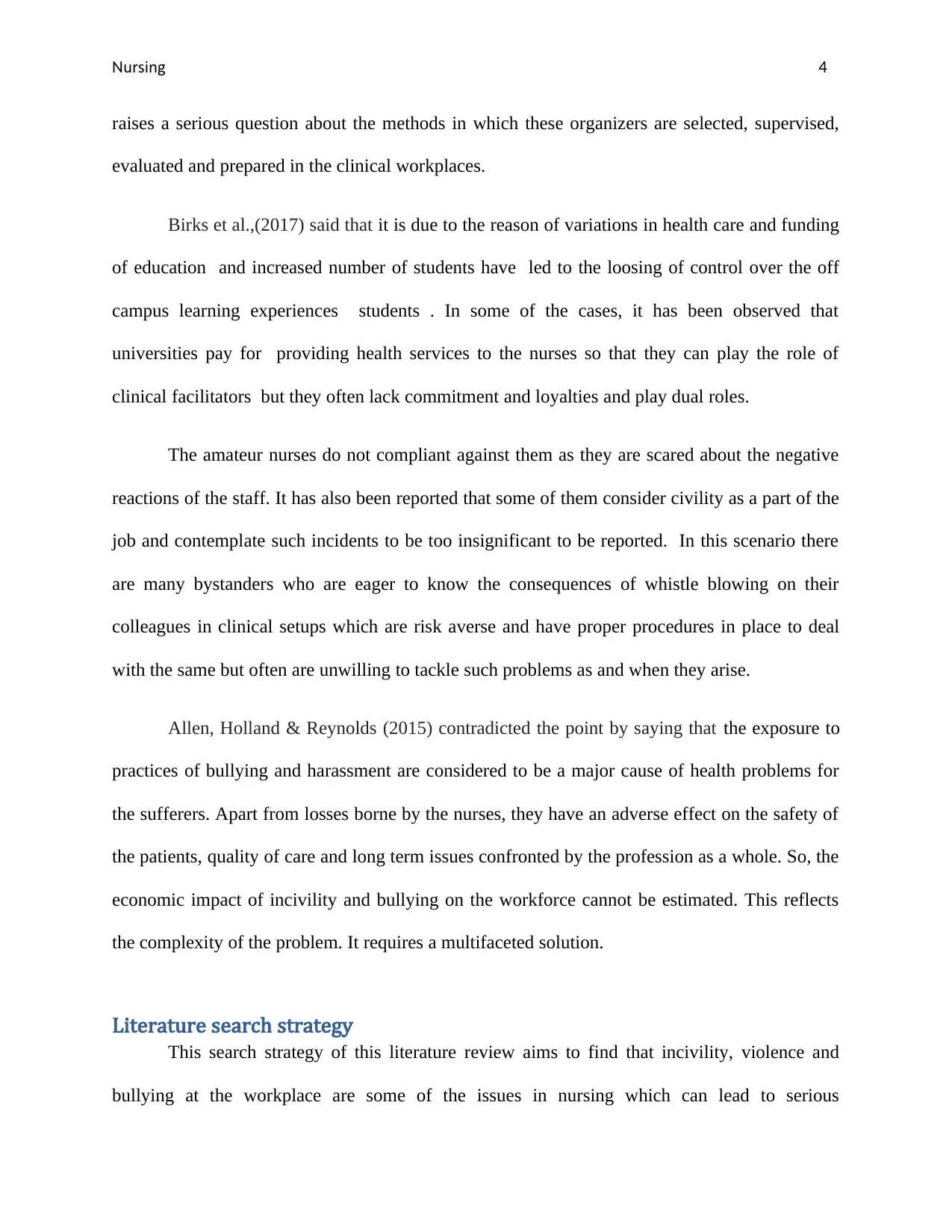
ursingN 4
raises a serious question about the methods in which these organizers are selected, supervised,
evaluated and prepared in the clinical workplaces.
Birks et al.,(2017) said that it is due to the reason of variations in health care and funding
of education and increased number of students have led to the loosing of control over the off
campus learning experiences students . In some of the cases, it has been observed that
universities pay for providing health services to the nurses so that they can play the role of
clinical facilitators but they often lack commitment and loyalties and play dual roles.
The amateur nurses do not compliant against them as they are scared about the negative
reactions of the staff. It has also been reported that some of them consider civility as a part of the
job and contemplate such incidents to be too insignificant to be reported. In this scenario there
are many bystanders who are eager to know the consequences of whistle blowing on their
colleagues in clinical setups which are risk averse and have proper procedures in place to deal
with the same but often are unwilling to tackle such problems as and when they arise.
Allen, Holland & Reynolds (2015) contradicted the point by saying that the exposure to
practices of bullying and harassment are considered to be a major cause of health problems for
the sufferers. Apart from losses borne by the nurses, they have an adverse effect on the safety of
the patients, quality of care and long term issues confronted by the profession as a whole. So, the
economic impact of incivility and bullying on the workforce cannot be estimated. This reflects
the complexity of the problem. It requires a multifaceted solution.
Literature search strategy
This search strategy of this literature review aims to find that incivility, violence and
bullying at the workplace are some of the issues in nursing which can lead to serious
raises a serious question about the methods in which these organizers are selected, supervised,
evaluated and prepared in the clinical workplaces.
Birks et al.,(2017) said that it is due to the reason of variations in health care and funding
of education and increased number of students have led to the loosing of control over the off
campus learning experiences students . In some of the cases, it has been observed that
universities pay for providing health services to the nurses so that they can play the role of
clinical facilitators but they often lack commitment and loyalties and play dual roles.
The amateur nurses do not compliant against them as they are scared about the negative
reactions of the staff. It has also been reported that some of them consider civility as a part of the
job and contemplate such incidents to be too insignificant to be reported. In this scenario there
are many bystanders who are eager to know the consequences of whistle blowing on their
colleagues in clinical setups which are risk averse and have proper procedures in place to deal
with the same but often are unwilling to tackle such problems as and when they arise.
Allen, Holland & Reynolds (2015) contradicted the point by saying that the exposure to
practices of bullying and harassment are considered to be a major cause of health problems for
the sufferers. Apart from losses borne by the nurses, they have an adverse effect on the safety of
the patients, quality of care and long term issues confronted by the profession as a whole. So, the
economic impact of incivility and bullying on the workforce cannot be estimated. This reflects
the complexity of the problem. It requires a multifaceted solution.
Literature search strategy
This search strategy of this literature review aims to find that incivility, violence and
bullying at the workplace are some of the issues in nursing which can lead to serious
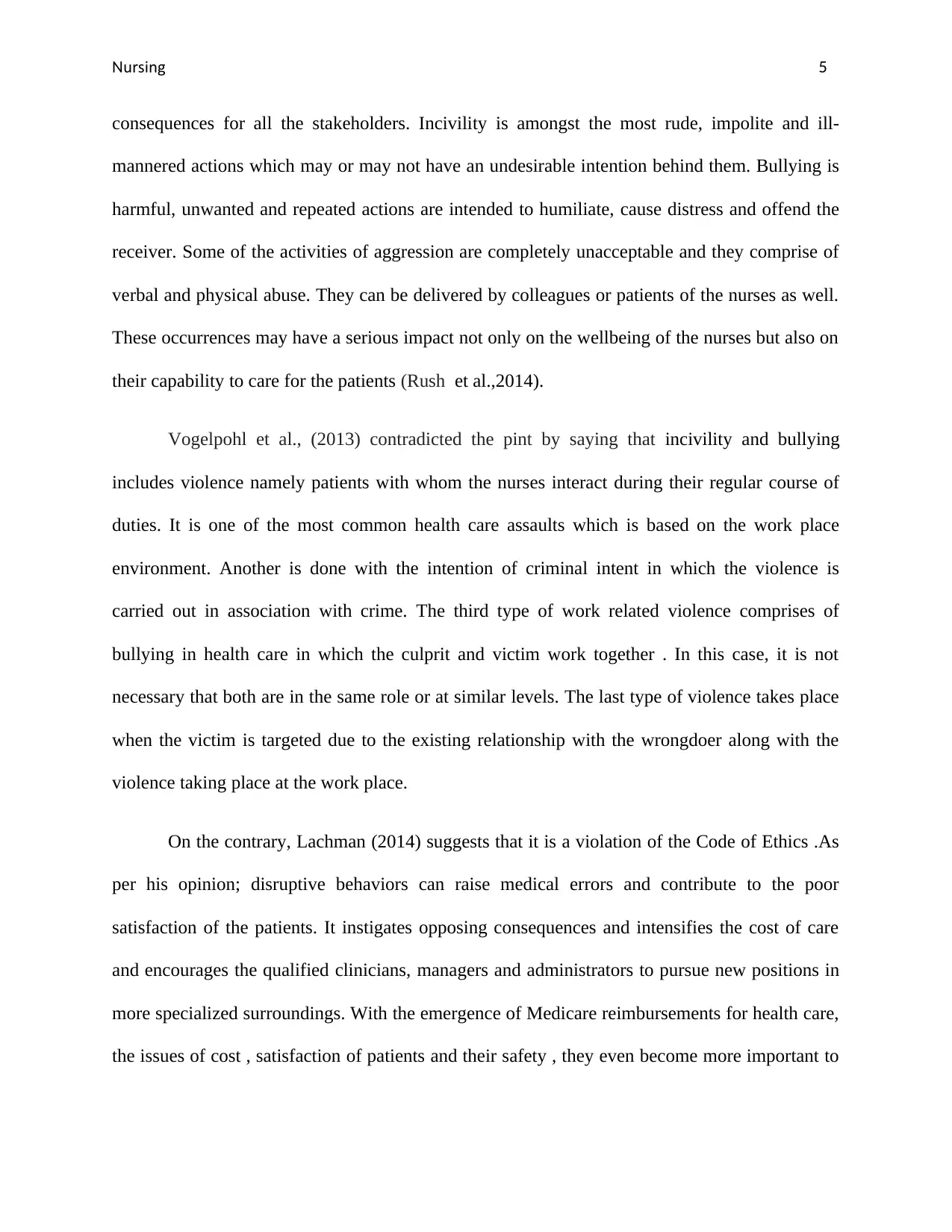
ursingN 5
consequences for all the stakeholders. Incivility is amongst the most rude, impolite and ill-
mannered actions which may or may not have an undesirable intention behind them. Bullying is
harmful, unwanted and repeated actions are intended to humiliate, cause distress and offend the
receiver. Some of the activities of aggression are completely unacceptable and they comprise of
verbal and physical abuse. They can be delivered by colleagues or patients of the nurses as well.
These occurrences may have a serious impact not only on the wellbeing of the nurses but also on
their capability to care for the patients (Rush et al.,2014).
Vogelpohl et al., (2013) contradicted the pint by saying that incivility and bullying
includes violence namely patients with whom the nurses interact during their regular course of
duties. It is one of the most common health care assaults which is based on the work place
environment. Another is done with the intention of criminal intent in which the violence is
carried out in association with crime. The third type of work related violence comprises of
bullying in health care in which the culprit and victim work together . In this case, it is not
necessary that both are in the same role or at similar levels. The last type of violence takes place
when the victim is targeted due to the existing relationship with the wrongdoer along with the
violence taking place at the work place.
On the contrary, Lachman (2014) suggests that it is a violation of the Code of Ethics .As
per his opinion; disruptive behaviors can raise medical errors and contribute to the poor
satisfaction of the patients. It instigates opposing consequences and intensifies the cost of care
and encourages the qualified clinicians, managers and administrators to pursue new positions in
more specialized surroundings. With the emergence of Medicare reimbursements for health care,
the issues of cost , satisfaction of patients and their safety , they even become more important to
consequences for all the stakeholders. Incivility is amongst the most rude, impolite and ill-
mannered actions which may or may not have an undesirable intention behind them. Bullying is
harmful, unwanted and repeated actions are intended to humiliate, cause distress and offend the
receiver. Some of the activities of aggression are completely unacceptable and they comprise of
verbal and physical abuse. They can be delivered by colleagues or patients of the nurses as well.
These occurrences may have a serious impact not only on the wellbeing of the nurses but also on
their capability to care for the patients (Rush et al.,2014).
Vogelpohl et al., (2013) contradicted the pint by saying that incivility and bullying
includes violence namely patients with whom the nurses interact during their regular course of
duties. It is one of the most common health care assaults which is based on the work place
environment. Another is done with the intention of criminal intent in which the violence is
carried out in association with crime. The third type of work related violence comprises of
bullying in health care in which the culprit and victim work together . In this case, it is not
necessary that both are in the same role or at similar levels. The last type of violence takes place
when the victim is targeted due to the existing relationship with the wrongdoer along with the
violence taking place at the work place.
On the contrary, Lachman (2014) suggests that it is a violation of the Code of Ethics .As
per his opinion; disruptive behaviors can raise medical errors and contribute to the poor
satisfaction of the patients. It instigates opposing consequences and intensifies the cost of care
and encourages the qualified clinicians, managers and administrators to pursue new positions in
more specialized surroundings. With the emergence of Medicare reimbursements for health care,
the issues of cost , satisfaction of patients and their safety , they even become more important to
⊘ This is a preview!⊘
Do you want full access?
Subscribe today to unlock all pages.

Trusted by 1+ million students worldwide
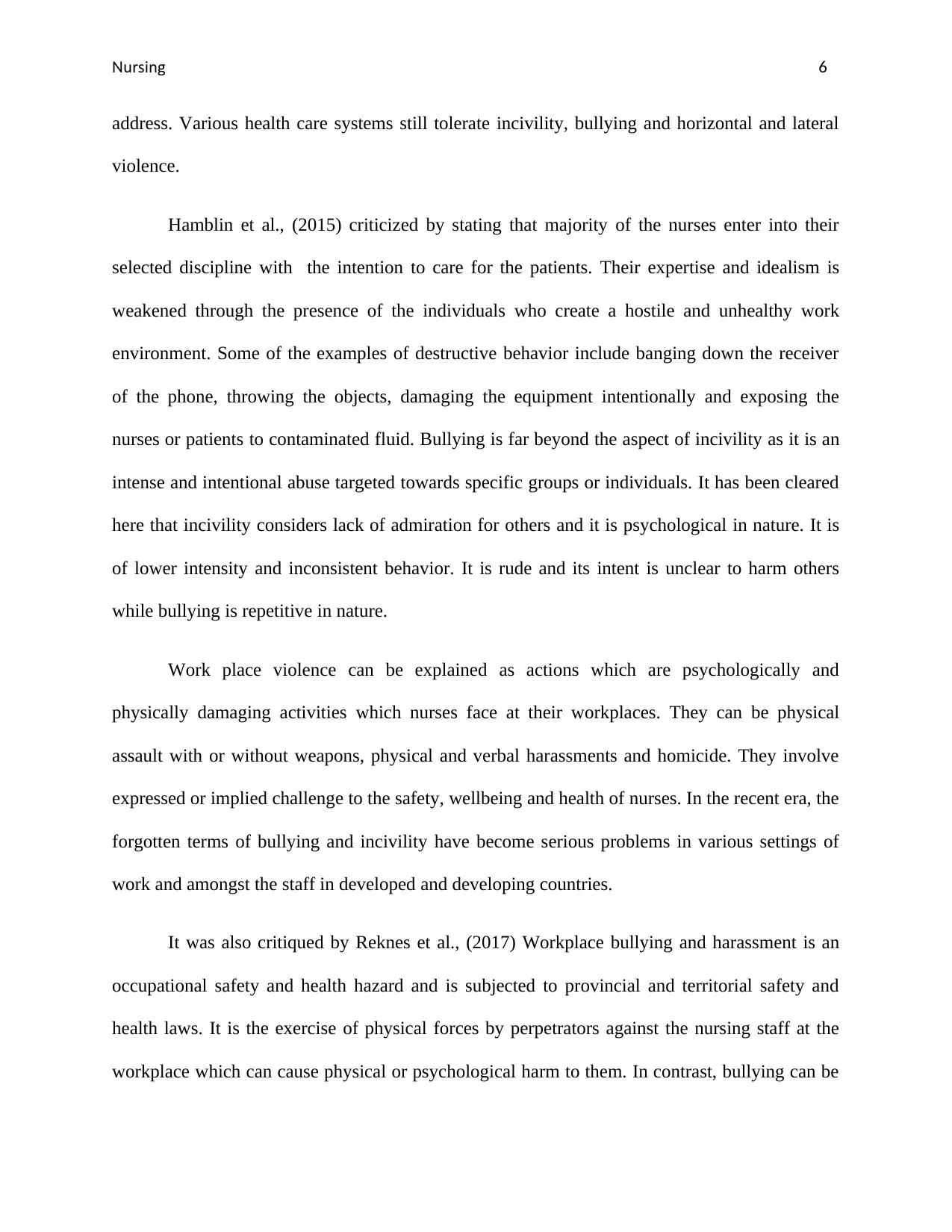
ursingN 6
address. Various health care systems still tolerate incivility, bullying and horizontal and lateral
violence.
Hamblin et al., (2015) criticized by stating that majority of the nurses enter into their
selected discipline with the intention to care for the patients. Their expertise and idealism is
weakened through the presence of the individuals who create a hostile and unhealthy work
environment. Some of the examples of destructive behavior include banging down the receiver
of the phone, throwing the objects, damaging the equipment intentionally and exposing the
nurses or patients to contaminated fluid. Bullying is far beyond the aspect of incivility as it is an
intense and intentional abuse targeted towards specific groups or individuals. It has been cleared
here that incivility considers lack of admiration for others and it is psychological in nature. It is
of lower intensity and inconsistent behavior. It is rude and its intent is unclear to harm others
while bullying is repetitive in nature.
Work place violence can be explained as actions which are psychologically and
physically damaging activities which nurses face at their workplaces. They can be physical
assault with or without weapons, physical and verbal harassments and homicide. They involve
expressed or implied challenge to the safety, wellbeing and health of nurses. In the recent era, the
forgotten terms of bullying and incivility have become serious problems in various settings of
work and amongst the staff in developed and developing countries.
It was also critiqued by Reknes et al., (2017) Workplace bullying and harassment is an
occupational safety and health hazard and is subjected to provincial and territorial safety and
health laws. It is the exercise of physical forces by perpetrators against the nursing staff at the
workplace which can cause physical or psychological harm to them. In contrast, bullying can be
address. Various health care systems still tolerate incivility, bullying and horizontal and lateral
violence.
Hamblin et al., (2015) criticized by stating that majority of the nurses enter into their
selected discipline with the intention to care for the patients. Their expertise and idealism is
weakened through the presence of the individuals who create a hostile and unhealthy work
environment. Some of the examples of destructive behavior include banging down the receiver
of the phone, throwing the objects, damaging the equipment intentionally and exposing the
nurses or patients to contaminated fluid. Bullying is far beyond the aspect of incivility as it is an
intense and intentional abuse targeted towards specific groups or individuals. It has been cleared
here that incivility considers lack of admiration for others and it is psychological in nature. It is
of lower intensity and inconsistent behavior. It is rude and its intent is unclear to harm others
while bullying is repetitive in nature.
Work place violence can be explained as actions which are psychologically and
physically damaging activities which nurses face at their workplaces. They can be physical
assault with or without weapons, physical and verbal harassments and homicide. They involve
expressed or implied challenge to the safety, wellbeing and health of nurses. In the recent era, the
forgotten terms of bullying and incivility have become serious problems in various settings of
work and amongst the staff in developed and developing countries.
It was also critiqued by Reknes et al., (2017) Workplace bullying and harassment is an
occupational safety and health hazard and is subjected to provincial and territorial safety and
health laws. It is the exercise of physical forces by perpetrators against the nursing staff at the
workplace which can cause physical or psychological harm to them. In contrast, bullying can be
Paraphrase This Document
Need a fresh take? Get an instant paraphrase of this document with our AI Paraphraser
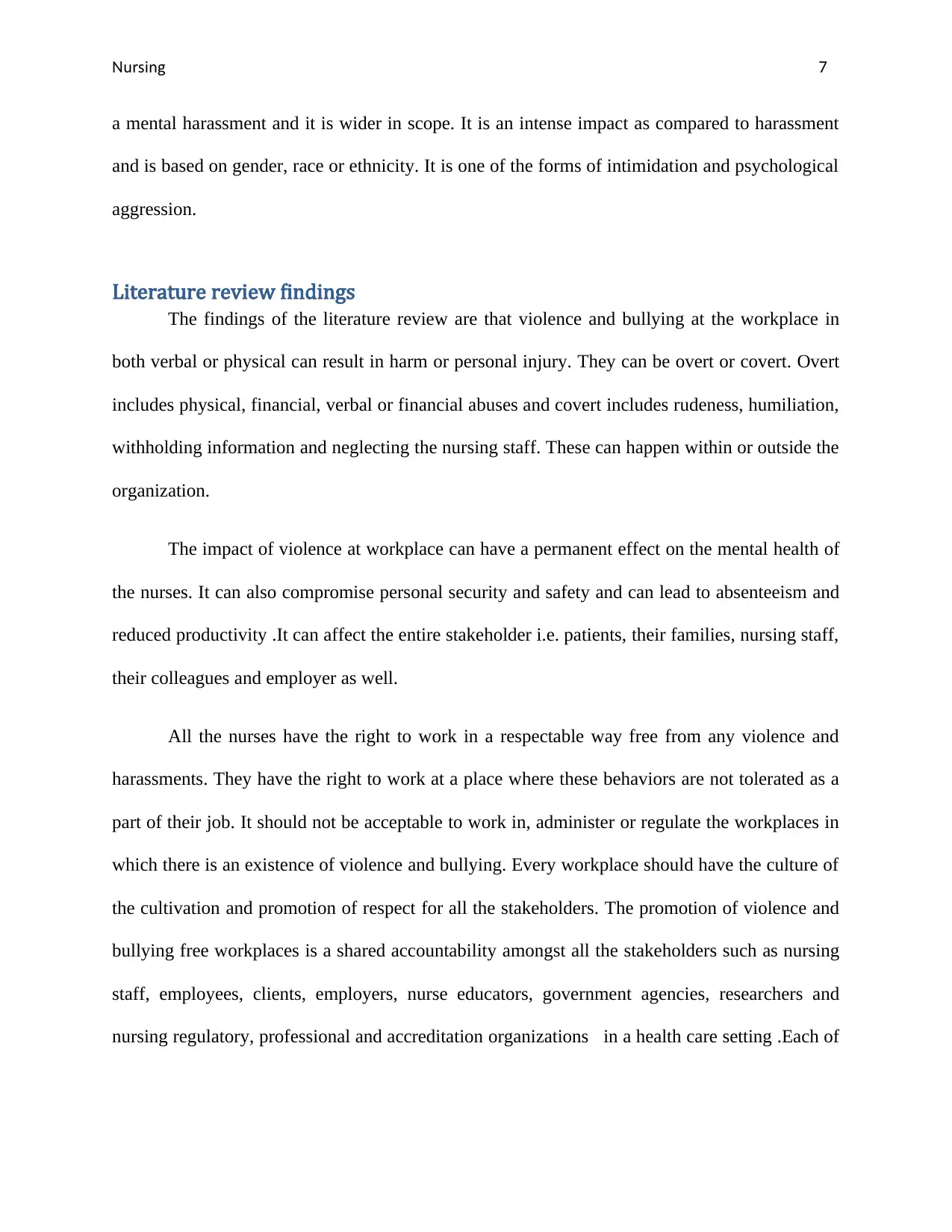
ursingN 7
a mental harassment and it is wider in scope. It is an intense impact as compared to harassment
and is based on gender, race or ethnicity. It is one of the forms of intimidation and psychological
aggression.
Literature review findings
The findings of the literature review are that violence and bullying at the workplace in
both verbal or physical can result in harm or personal injury. They can be overt or covert. Overt
includes physical, financial, verbal or financial abuses and covert includes rudeness, humiliation,
withholding information and neglecting the nursing staff. These can happen within or outside the
organization.
The impact of violence at workplace can have a permanent effect on the mental health of
the nurses. It can also compromise personal security and safety and can lead to absenteeism and
reduced productivity .It can affect the entire stakeholder i.e. patients, their families, nursing staff,
their colleagues and employer as well.
All the nurses have the right to work in a respectable way free from any violence and
harassments. They have the right to work at a place where these behaviors are not tolerated as a
part of their job. It should not be acceptable to work in, administer or regulate the workplaces in
which there is an existence of violence and bullying. Every workplace should have the culture of
the cultivation and promotion of respect for all the stakeholders. The promotion of violence and
bullying free workplaces is a shared accountability amongst all the stakeholders such as nursing
staff, employees, clients, employers, nurse educators, government agencies, researchers and
nursing regulatory, professional and accreditation organizations in a health care setting .Each of
a mental harassment and it is wider in scope. It is an intense impact as compared to harassment
and is based on gender, race or ethnicity. It is one of the forms of intimidation and psychological
aggression.
Literature review findings
The findings of the literature review are that violence and bullying at the workplace in
both verbal or physical can result in harm or personal injury. They can be overt or covert. Overt
includes physical, financial, verbal or financial abuses and covert includes rudeness, humiliation,
withholding information and neglecting the nursing staff. These can happen within or outside the
organization.
The impact of violence at workplace can have a permanent effect on the mental health of
the nurses. It can also compromise personal security and safety and can lead to absenteeism and
reduced productivity .It can affect the entire stakeholder i.e. patients, their families, nursing staff,
their colleagues and employer as well.
All the nurses have the right to work in a respectable way free from any violence and
harassments. They have the right to work at a place where these behaviors are not tolerated as a
part of their job. It should not be acceptable to work in, administer or regulate the workplaces in
which there is an existence of violence and bullying. Every workplace should have the culture of
the cultivation and promotion of respect for all the stakeholders. The promotion of violence and
bullying free workplaces is a shared accountability amongst all the stakeholders such as nursing
staff, employees, clients, employers, nurse educators, government agencies, researchers and
nursing regulatory, professional and accreditation organizations in a health care setting .Each of
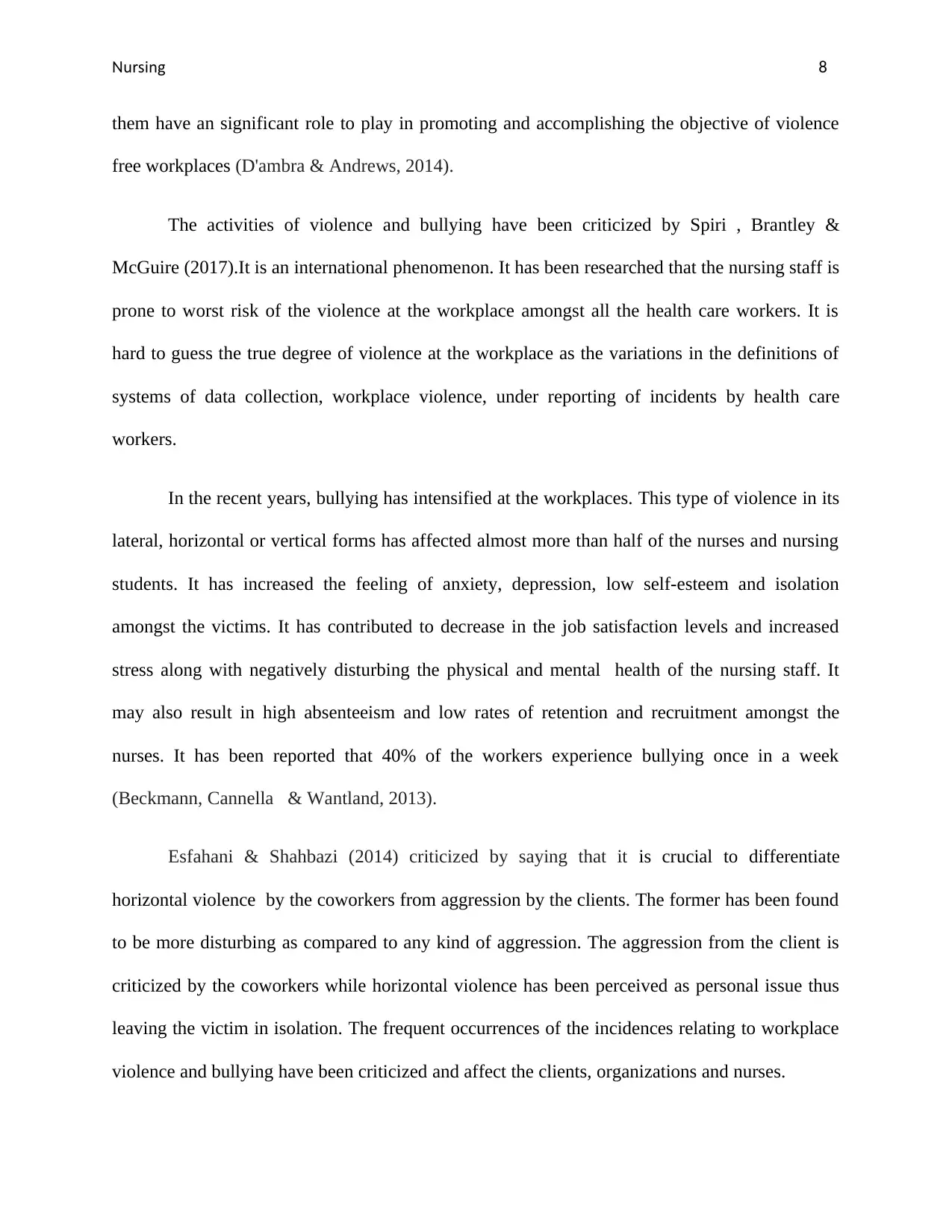
ursingN 8
them have an significant role to play in promoting and accomplishing the objective of violence
free workplaces (D'ambra & Andrews, 2014).
The activities of violence and bullying have been criticized by Spiri , Brantley &
McGuire (2017).It is an international phenomenon. It has been researched that the nursing staff is
prone to worst risk of the violence at the workplace amongst all the health care workers. It is
hard to guess the true degree of violence at the workplace as the variations in the definitions of
systems of data collection, workplace violence, under reporting of incidents by health care
workers.
In the recent years, bullying has intensified at the workplaces. This type of violence in its
lateral, horizontal or vertical forms has affected almost more than half of the nurses and nursing
students. It has increased the feeling of anxiety, depression, low self-esteem and isolation
amongst the victims. It has contributed to decrease in the job satisfaction levels and increased
stress along with negatively disturbing the physical and mental health of the nursing staff. It
may also result in high absenteeism and low rates of retention and recruitment amongst the
nurses. It has been reported that 40% of the workers experience bullying once in a week
(Beckmann, Cannella & Wantland, 2013).
Esfahani & Shahbazi (2014) criticized by saying that it is crucial to differentiate
horizontal violence by the coworkers from aggression by the clients. The former has been found
to be more disturbing as compared to any kind of aggression. The aggression from the client is
criticized by the coworkers while horizontal violence has been perceived as personal issue thus
leaving the victim in isolation. The frequent occurrences of the incidences relating to workplace
violence and bullying have been criticized and affect the clients, organizations and nurses.
them have an significant role to play in promoting and accomplishing the objective of violence
free workplaces (D'ambra & Andrews, 2014).
The activities of violence and bullying have been criticized by Spiri , Brantley &
McGuire (2017).It is an international phenomenon. It has been researched that the nursing staff is
prone to worst risk of the violence at the workplace amongst all the health care workers. It is
hard to guess the true degree of violence at the workplace as the variations in the definitions of
systems of data collection, workplace violence, under reporting of incidents by health care
workers.
In the recent years, bullying has intensified at the workplaces. This type of violence in its
lateral, horizontal or vertical forms has affected almost more than half of the nurses and nursing
students. It has increased the feeling of anxiety, depression, low self-esteem and isolation
amongst the victims. It has contributed to decrease in the job satisfaction levels and increased
stress along with negatively disturbing the physical and mental health of the nursing staff. It
may also result in high absenteeism and low rates of retention and recruitment amongst the
nurses. It has been reported that 40% of the workers experience bullying once in a week
(Beckmann, Cannella & Wantland, 2013).
Esfahani & Shahbazi (2014) criticized by saying that it is crucial to differentiate
horizontal violence by the coworkers from aggression by the clients. The former has been found
to be more disturbing as compared to any kind of aggression. The aggression from the client is
criticized by the coworkers while horizontal violence has been perceived as personal issue thus
leaving the victim in isolation. The frequent occurrences of the incidences relating to workplace
violence and bullying have been criticized and affect the clients, organizations and nurses.
⊘ This is a preview!⊘
Do you want full access?
Subscribe today to unlock all pages.

Trusted by 1+ million students worldwide
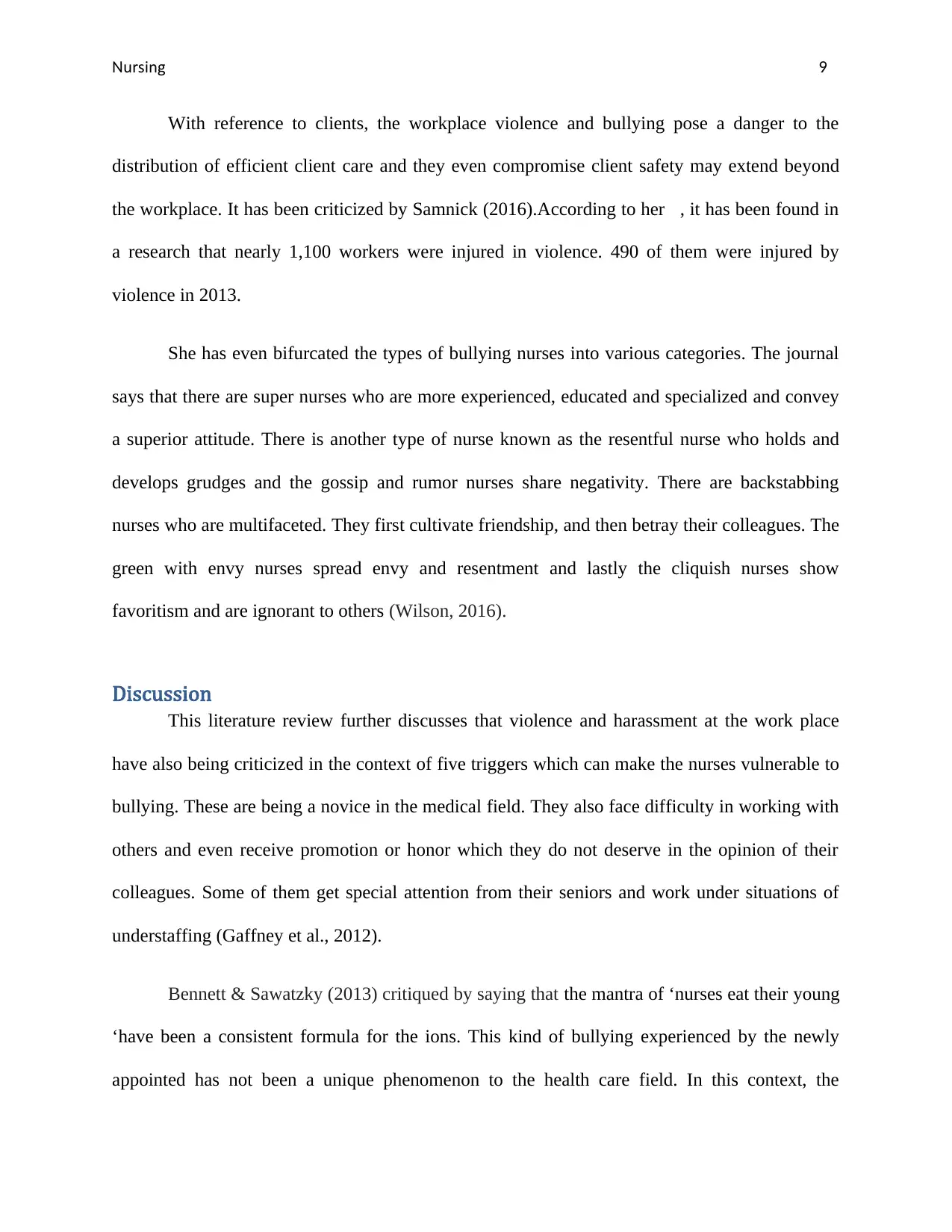
ursingN 9
With reference to clients, the workplace violence and bullying pose a danger to the
distribution of efficient client care and they even compromise client safety may extend beyond
the workplace. It has been criticized by Samnick (2016).According to her , it has been found in
a research that nearly 1,100 workers were injured in violence. 490 of them were injured by
violence in 2013.
She has even bifurcated the types of bullying nurses into various categories. The journal
says that there are super nurses who are more experienced, educated and specialized and convey
a superior attitude. There is another type of nurse known as the resentful nurse who holds and
develops grudges and the gossip and rumor nurses share negativity. There are backstabbing
nurses who are multifaceted. They first cultivate friendship, and then betray their colleagues. The
green with envy nurses spread envy and resentment and lastly the cliquish nurses show
favoritism and are ignorant to others (Wilson, 2016).
Discussion
This literature review further discusses that violence and harassment at the work place
have also being criticized in the context of five triggers which can make the nurses vulnerable to
bullying. These are being a novice in the medical field. They also face difficulty in working with
others and even receive promotion or honor which they do not deserve in the opinion of their
colleagues. Some of them get special attention from their seniors and work under situations of
understaffing (Gaffney et al., 2012).
Bennett & Sawatzky (2013) critiqued by saying that the mantra of ‘nurses eat their young
‘have been a consistent formula for the ions. This kind of bullying experienced by the newly
appointed has not been a unique phenomenon to the health care field. In this context, the
With reference to clients, the workplace violence and bullying pose a danger to the
distribution of efficient client care and they even compromise client safety may extend beyond
the workplace. It has been criticized by Samnick (2016).According to her , it has been found in
a research that nearly 1,100 workers were injured in violence. 490 of them were injured by
violence in 2013.
She has even bifurcated the types of bullying nurses into various categories. The journal
says that there are super nurses who are more experienced, educated and specialized and convey
a superior attitude. There is another type of nurse known as the resentful nurse who holds and
develops grudges and the gossip and rumor nurses share negativity. There are backstabbing
nurses who are multifaceted. They first cultivate friendship, and then betray their colleagues. The
green with envy nurses spread envy and resentment and lastly the cliquish nurses show
favoritism and are ignorant to others (Wilson, 2016).
Discussion
This literature review further discusses that violence and harassment at the work place
have also being criticized in the context of five triggers which can make the nurses vulnerable to
bullying. These are being a novice in the medical field. They also face difficulty in working with
others and even receive promotion or honor which they do not deserve in the opinion of their
colleagues. Some of them get special attention from their seniors and work under situations of
understaffing (Gaffney et al., 2012).
Bennett & Sawatzky (2013) critiqued by saying that the mantra of ‘nurses eat their young
‘have been a consistent formula for the ions. This kind of bullying experienced by the newly
appointed has not been a unique phenomenon to the health care field. In this context, the
Paraphrase This Document
Need a fresh take? Get an instant paraphrase of this document with our AI Paraphraser
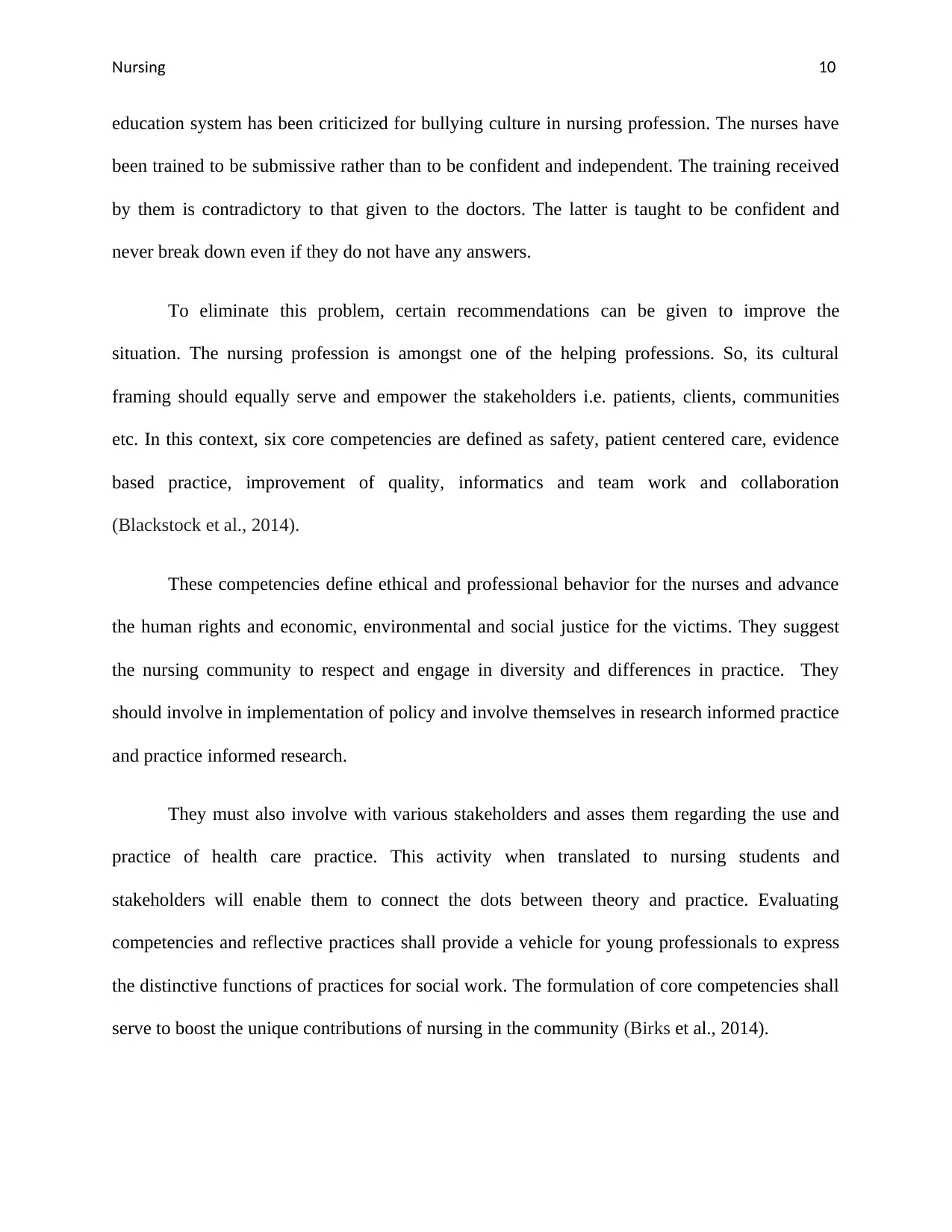
ursingN 10
education system has been criticized for bullying culture in nursing profession. The nurses have
been trained to be submissive rather than to be confident and independent. The training received
by them is contradictory to that given to the doctors. The latter is taught to be confident and
never break down even if they do not have any answers.
To eliminate this problem, certain recommendations can be given to improve the
situation. The nursing profession is amongst one of the helping professions. So, its cultural
framing should equally serve and empower the stakeholders i.e. patients, clients, communities
etc. In this context, six core competencies are defined as safety, patient centered care, evidence
based practice, improvement of quality, informatics and team work and collaboration
(Blackstock et al., 2014).
These competencies define ethical and professional behavior for the nurses and advance
the human rights and economic, environmental and social justice for the victims. They suggest
the nursing community to respect and engage in diversity and differences in practice. They
should involve in implementation of policy and involve themselves in research informed practice
and practice informed research.
They must also involve with various stakeholders and asses them regarding the use and
practice of health care practice. This activity when translated to nursing students and
stakeholders will enable them to connect the dots between theory and practice. Evaluating
competencies and reflective practices shall provide a vehicle for young professionals to express
the distinctive functions of practices for social work. The formulation of core competencies shall
serve to boost the unique contributions of nursing in the community (Birks et al., 2014).
education system has been criticized for bullying culture in nursing profession. The nurses have
been trained to be submissive rather than to be confident and independent. The training received
by them is contradictory to that given to the doctors. The latter is taught to be confident and
never break down even if they do not have any answers.
To eliminate this problem, certain recommendations can be given to improve the
situation. The nursing profession is amongst one of the helping professions. So, its cultural
framing should equally serve and empower the stakeholders i.e. patients, clients, communities
etc. In this context, six core competencies are defined as safety, patient centered care, evidence
based practice, improvement of quality, informatics and team work and collaboration
(Blackstock et al., 2014).
These competencies define ethical and professional behavior for the nurses and advance
the human rights and economic, environmental and social justice for the victims. They suggest
the nursing community to respect and engage in diversity and differences in practice. They
should involve in implementation of policy and involve themselves in research informed practice
and practice informed research.
They must also involve with various stakeholders and asses them regarding the use and
practice of health care practice. This activity when translated to nursing students and
stakeholders will enable them to connect the dots between theory and practice. Evaluating
competencies and reflective practices shall provide a vehicle for young professionals to express
the distinctive functions of practices for social work. The formulation of core competencies shall
serve to boost the unique contributions of nursing in the community (Birks et al., 2014).
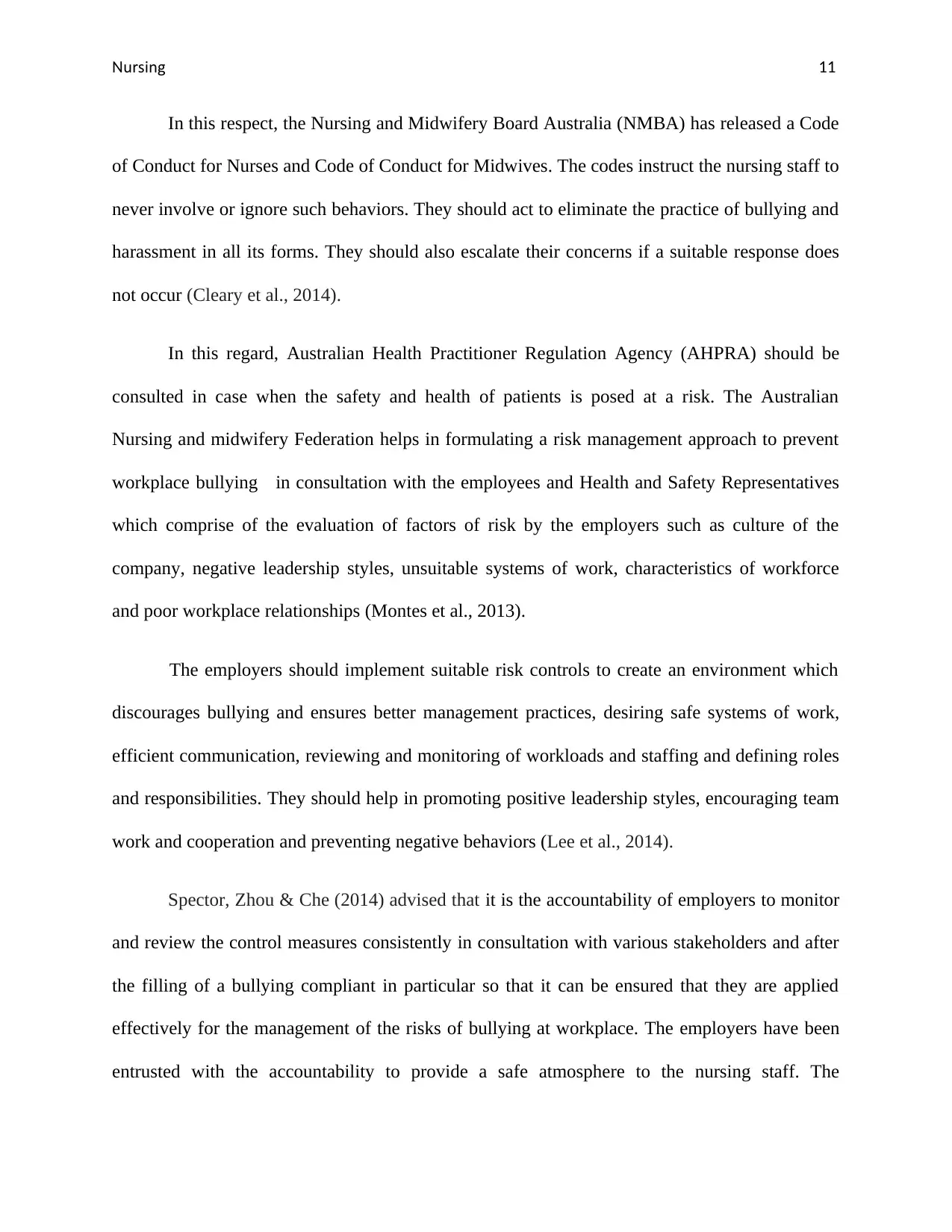
ursingN 11
In this respect, the Nursing and Midwifery Board Australia (NMBA) has released a Code
of Conduct for Nurses and Code of Conduct for Midwives. The codes instruct the nursing staff to
never involve or ignore such behaviors. They should act to eliminate the practice of bullying and
harassment in all its forms. They should also escalate their concerns if a suitable response does
not occur (Cleary et al., 2014).
In this regard, Australian Health Practitioner Regulation Agency (AHPRA) should be
consulted in case when the safety and health of patients is posed at a risk. The Australian
Nursing and midwifery Federation helps in formulating a risk management approach to prevent
workplace bullying in consultation with the employees and Health and Safety Representatives
which comprise of the evaluation of factors of risk by the employers such as culture of the
company, negative leadership styles, unsuitable systems of work, characteristics of workforce
and poor workplace relationships (Montes et al., 2013).
The employers should implement suitable risk controls to create an environment which
discourages bullying and ensures better management practices, desiring safe systems of work,
efficient communication, reviewing and monitoring of workloads and staffing and defining roles
and responsibilities. They should help in promoting positive leadership styles, encouraging team
work and cooperation and preventing negative behaviors (Lee et al., 2014).
Spector, Zhou & Che (2014) advised that it is the accountability of employers to monitor
and review the control measures consistently in consultation with various stakeholders and after
the filling of a bullying compliant in particular so that it can be ensured that they are applied
effectively for the management of the risks of bullying at workplace. The employers have been
entrusted with the accountability to provide a safe atmosphere to the nursing staff. The
In this respect, the Nursing and Midwifery Board Australia (NMBA) has released a Code
of Conduct for Nurses and Code of Conduct for Midwives. The codes instruct the nursing staff to
never involve or ignore such behaviors. They should act to eliminate the practice of bullying and
harassment in all its forms. They should also escalate their concerns if a suitable response does
not occur (Cleary et al., 2014).
In this regard, Australian Health Practitioner Regulation Agency (AHPRA) should be
consulted in case when the safety and health of patients is posed at a risk. The Australian
Nursing and midwifery Federation helps in formulating a risk management approach to prevent
workplace bullying in consultation with the employees and Health and Safety Representatives
which comprise of the evaluation of factors of risk by the employers such as culture of the
company, negative leadership styles, unsuitable systems of work, characteristics of workforce
and poor workplace relationships (Montes et al., 2013).
The employers should implement suitable risk controls to create an environment which
discourages bullying and ensures better management practices, desiring safe systems of work,
efficient communication, reviewing and monitoring of workloads and staffing and defining roles
and responsibilities. They should help in promoting positive leadership styles, encouraging team
work and cooperation and preventing negative behaviors (Lee et al., 2014).
Spector, Zhou & Che (2014) advised that it is the accountability of employers to monitor
and review the control measures consistently in consultation with various stakeholders and after
the filling of a bullying compliant in particular so that it can be ensured that they are applied
effectively for the management of the risks of bullying at workplace. The employers have been
entrusted with the accountability to provide a safe atmosphere to the nursing staff. The
⊘ This is a preview!⊘
Do you want full access?
Subscribe today to unlock all pages.

Trusted by 1+ million students worldwide
1 out of 24
Related Documents
Your All-in-One AI-Powered Toolkit for Academic Success.
+13062052269
info@desklib.com
Available 24*7 on WhatsApp / Email
![[object Object]](/_next/static/media/star-bottom.7253800d.svg)
Unlock your academic potential
Copyright © 2020–2025 A2Z Services. All Rights Reserved. Developed and managed by ZUCOL.





